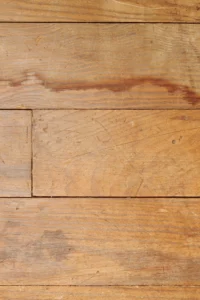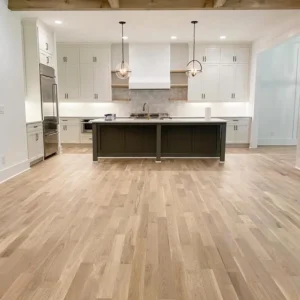Many homeowners see steam cleaning as a convenient and eco-friendly cleaning method for a variety of surfaces.
Tile, upholstery— steam cleaning is famous for its ability to remove dirt and grime without needing harsh chemicals. But is there a catch?
When it comes to hardwood floors, can you steam clean hardwood floors?
Let’s delve into the details to understand the impact of steam cleaning on hardwood floors and explore alternative cleaning methods to keep your hardwood floors looking their best.
Understanding Hardwood Floors
To understand why steam cleaning may not be suitable for hardwood floors, it’s important to first grasp the basics of hardwood floor composition.
Hardwood floors are made from natural wood that is processed into planks, providing a warm, classic look to any space. Unlike engineered wood or laminate, which are synthetic materials, hardwood is entirely natural and adds a unique touch of elegance to a home.
In order to preserve the beauty and longevity of hardwood floors, you’ll need to have proper maintenance. You probably already know regular hardwood floor maintenance, like:
- Regular sweeping
- Vacuuming
- Using a damp mop with a hardwood floor cleaner specifically formulated for wood surfaces
But despite how durability of hardwood floors, there are a few common misconceptions about cleaning them— one of them being that excessive moisture is safe for hardwood floors.

While some moisture is necessary for cleaning, too much can seep into the wood, causing it to swell, warp, or even crack over time.
Another misconception is that all cleaning products are safe for hardwood floors!
Using harsh chemicals or abrasive cleaners can strip away the finish and damage the wood, leading to costly repairs or refinishing. This is why we always recommend only using manufacturer-approved hardwood floor cleaners!
How Steam Cleaning Works
You might be curious if you can clean hardwood floors with steam— so let’s talk about it!
Steam cleaning involves using a steam cleaner, which heats water to create steam. The steam is then applied to the surface being cleaned, loosening dirt and grime, which can be wiped away with a cloth or vacuumed up.
One of the main benefits of steam cleaning is its ability to kill germs and bacteria without the need for harsh chemicals. The heat from the steam can effectively sanitize surfaces, making it a popular choice for households with small children or pets.
Additionally, steam cleaning is effective at removing tough stains, such as those from food spills or pet accidents. The heat from the steam helps to break down the stains, making them easier to clean.
Can You Steam Clean Hardwood Floors? (No!)
Hardwood floors are sensitive to moisture and heat, both of which are present in steam cleaning. The moisture from the steam can seep into the wood, causing it to swell and warp.
Tthe heat from the steam can also damage the finish on the wood, leading to discoloration or even cracking.
Our answer to “Can you steam clean hardwood floors?:” No!
While steam cleaning has become a popular cleaning method for many surfaces, we don’t recommend it, because it can cause significant damage to hardwood floors due to the combination of excessive moisture and heat. Here’s why:
- Hardwood floors are porous, meaning they can absorb moisture. When they’re exposed to steam, the moisture can penetrate the wood, causing it to swell and warp. Over time, this can lead to cupping or buckling of the floorboards, requiring costly repairs or replacement.
- Excessive heat can cause the wood to dry out and shrink, leading to gaps between the floorboards. This can not only affect the appearance of the floors but also make them more susceptible to further damage.
- Using a steam cleaner on hardwood floors can void warranties offered by flooring manufacturers. Many hardwood floor warranties specify that only certain cleaning methods should be used to maintain the warranty coverage.
Using a steam cleaner, which is not recommended for hardwood floors, can void this warranty protection!
So, what should you use instead? Can you clean hardwood floors with a steam mop?
Nope— instead, use a damp mop with a hardwood floor cleaner specifically formulated for wood surfaces. This will help to clean and maintain your hardwood floors without causing any damage.

How Steam Clean Damages Different Types of Hardwood Floors
Can You Steam Clean Engineered Hardwood Floors?
Engineered hardwood floors are constructed with a top layer of real hardwood veneer, making them more resistant to moisture and heat than solid hardwood floors. However, steam cleaning can still cause damage to engineered hardwood floors due to the unique way they are constructed.
One of the main issues with steam cleaning engineered hardwood floors is that the moisture from the steam can penetrate the top layer of the flooring.
While engineered hardwood is more resistant to moisture than solid hardwood, excessive moisture can still seep into the wood, causing it to swell and warp. This can lead to unsightly bumps and ridges in the flooring, affecting both its appearance and structural integrity.
Additionally, the heat from the steam can damage the adhesive used in engineered hardwood floors. Engineered hardwood floors are made by layering plywood or fiberboard with a hardwood veneer on top.
The adhesive used to bond these layers together can soften or break down when exposed to heat, compromising the stability of the flooring.
Can You Steam Clean Reclaimed Hardwood Floors?
Reclaimed hardwood floors are prized for their unique character and history, often salvaged from old buildings or structures. While these floors add a charming, rustic look to any space, they are more susceptible to damage from steam cleaning due to their age and lack of protective finishes.
Unfortunately, when steam cleaning reclaimed hardwood floors, the steam can easily penetrate the surface of the wood. Unlike newer hardwood floors that are sealed with protective finishes, reclaimed hardwood floors may lack this protective layer, making them more vulnerable to moisture penetration.
As a result, the moisture from the steam can cause the wood to expand and contract, leading to cupping or buckling of the floorboards.
Additionally, steam cleaning can damage the patina or aged appearance of reclaimed hardwood floors. The heat from the steam can soften or remove the natural oils and finishes that give reclaimed hardwood its unique look. This can result in a loss of color or sheen, detracting from the beauty and character of the flooring.
Can You Steam Clean Laminate Hardwood Floors?
Laminate hardwood floors are a popular choice for homeowners due to their affordability and durability. However, they are not designed to withstand moisture from steam cleaning, which can cause significant damage to the flooring.
But laminate hardwood floors are not designed to handle excessive moisture. They’re composed of multiple layers, including a decorative layer, a core layer, and a wear layer.
The core layer is typically made of high-density fiberboard (HDF), which is susceptible to swelling when exposed to moisture. Steam cleaning can cause the core layer to swell and break apart, leading to warping and buckling of the flooring.
Additionally, the heat from the steam can damage the decorative layer of laminate hardwood floors. The decorative layer is a high-resolution image that gives the flooring its wood-like appearance. The heat from the steam can cause the image to fade or warp, detracting from the aesthetic appeal of the flooring.

How to Clean Hardwood Floors (Without Steam Cleaning!)
We don’t recommend steam cleaning, but there are some other safe and effective alternatives we can recommend.
These alternatives preserve the appearance and longevity of hardwood floors and protect them from future damage!
- Use a damp mop: Instead of steam cleaning, use a damp mop with a hardwood floor cleaner specifically formulated for wood surfaces. This method helps remove dirt and grime without exposing the wood to excessive moisture.
- Avoid excessive water: When cleaning hardwood floors, avoid using excessive water, as it can seep into the wood and cause damage. Instead, wring out the mop thoroughly to ensure it is only damp.
- Sweep regularly: Regular sweeping or vacuuming helps remove dirt and debris that can scratch the surface of hardwood floors. Use a soft-bristled broom or a vacuum with a hardwood floor attachment to avoid damaging the wood.
- Use area rugs and mats: Place area rugs and mats in high-traffic areas and near entryways to protect hardwood floors from dirt and moisture. Be sure to use rugs with non-slip backing to prevent them from sliding and scratching the floor.
- Wipe up spills promptly with a dry or damp cloth to prevent them from seeping into the wood.
- Avoid harsh chemicals: When cleaning hardwood floors, avoid using harsh chemicals or abrasive cleaners, as they can strip away the finish and damage the wood. Instead, use a hardwood floor cleaner that’s formulated for wood surfaces.
TriArt— Hardwood Floor Professionals At Your Service!
Transform your hardwood floors with TriArt! Our expert team provides top-notch hardwood floor services, from installation to refinishing!
Contact us today to schedule a consultation and discover the beauty of your hardwood floors— the right way. 😉

